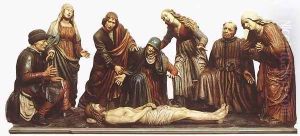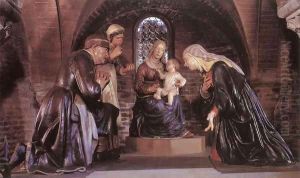Guido Mazzoni Paintings
Guido Mazzoni, also known as Paganino or Il Modanino, was a distinguished Italian sculptor and painter of the late 15th and early 16th centuries, celebrated primarily for his emotive and detailed terracotta sculptures. Born in Modena, Italy, around 1445, Mazzoni's work reflects the transition from the late Gothic style to the early Renaissance. Despite the scarcity of documented details about his life, his surviving works and their impact on the art world of his time provide valuable insights into his artistic journey and the cultural context in which he operated.
Mazzoni's artistic career is best remembered for his emotionally charged, life-sized terracotta groups depicting religious scenes, most notably the Lamentation over the Dead Christ. These works are noted for their dramatic realism and the intense expression of grief, showcasing Mazzoni's skill in capturing human emotion. His figures, dressed in contemporary clothing, highlight his ability to blend sacred themes with the tangible reality of his time, making his works particularly resonant with viewers. Mazzoni's sculptures are characterized by their intricate detail and the vivid, expressive faces, which demonstrate his deep understanding of human anatomy and emotion.
Beyond his terracotta sculptures, Mazzoni was also a painter, although fewer of his paintings have survived. His style in painting, much like his sculptural work, demonstrated a keen attention to emotional depth and realism. Throughout his career, Mazzoni received commissions from high-profile patrons, including the Este family in Ferrara, which attests to his renown and the high regard in which he was held. His work had a significant influence on the development of sculptural practice in Italy, especially in the use of terracotta for life-sized, emotionally charged religious scenes.
Guido Mazzoni died in 1518, leaving behind a legacy that has been somewhat overshadowed by other Renaissance masters. Despite this, his contributions to the development of Italian Renaissance sculpture and his innovative use of terracotta remain important. Today, his works can be found in various Italian churches and museums, where they continue to be studied and admired for their emotional power and technical mastery. Mazzoni's ability to convey deep human emotion through his sculptures has earned him a lasting place in the history of art, making him a pivotal figure in the transition from the Gothic to the Renaissance style in Italian sculpture.

